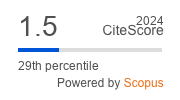Design Science Research: Balancing Science and Art in Building a Game Applied to Health
DOI:
https://doi.org/10.5753/jis.2022.2682Keywords:
Design Science Research, DSR, Applied Game, Serious Game, Arterial HypertensionAbstract
In the field of applied computing, such as in the development of games applied to health, there is a growing interweaving of two distinct fields: ”Science” and ”Art”. The methodology of Design Science Research (DSR) can contribute by directing with greater scientific rigor the development of technology-oriented research. The objective of this paper is to present and discuss the use of the DSR methodology in applied computing research, in which the developed artifact is a game applied to health. Three development cycles were defined. The first cycle prioritizes the understanding of the problem, the second defines the development of the main artifact, and the third, in turn, deals with the evaluation of the artifact. In this way, it was possible to instantiate a DSR model and generate artifacts that contribute to the understanding and the practical development of the solution. We also present a discussion about the conduct of the research and adaptations that this model could receive for research focused on game design for applied game development. The conclusion is that a balance between ”Science” and ”Art” results in innovative work that is in demand for production.
Downloads
References
Alexandre, N. M. C. and Coluci, M. Z. O. (2011). Validade de conteúdo nos processos de construção e adaptação de instrumentos de medidas. Ciência & Saúde Coletiva, 16(7):3061–3068.
Bayrak, A. T. (2020). Compassionate game design: A holistic perspective for a player-centric game design paradigm for games4health. International Journal on Advances in Intelligent Systems, 13(1):1–18.
Cota, T. T., Junior, N. V., and Ishitani, L. (2014). Impacto do gênero de jogo digital na motivação dos idosos para jogar. Simpósio Brasileiro de Jogos e Entretenimento Digital, 13(2014):361–368.
de Oliveira Santos, L. G. N., Ishitani, L., and Nobre, C. N. (2013). Uso de jogos casuais em celulares por idosos: um estudo de usabilidade. Revista de informática aplicada.
Denning, P. J. (2005). Is computer science science? Communications of the ACM, 48(4):27–31.
Dresch, A., Lacerda, D. P., and Júnior, J. A. V. A. (2015). Design science research: método de pesquisa para avanço da ciência e tecnologia. Bookman Editora.
Gelain, A., Watanabe, A. T. Y., Fouto, M. S., Bosse, R., and da Silva Hounsell, M. (2014). Uma breve história da computação aplicada no brasil. Revista Brasileira de Computação Aplicada, 6(2):123–135.
Kübler-Ross, E. and Kessler, D. (2005). On grief and grieving: Finding the meaning of grief through the five stages of loss. Simon and Schuster.
Leitao, T., Ferreira da Silva, F., and Xexéo, G. (2021). Análise de métodos de design de jogos sérios sob a ótica da design science research.
Muñoz, J. E. and Dautenhahn, K. (2021). Robo ludens: A game design taxonomy for multiplayer games using socially interactive robots. ACM Transactions on HumanRobot Interaction (THRI), 10(4):1–28.
Oliveira, L. and Carvalho, S. (2017). Gamificação como estratégia para promover self-care e engajar pacientes: Uma revisão sistemática da literatura. In SBGames 2017.
Oliveira, L., Oliveira, S., de Lima Vieira dos Santos, S., and Carvalho, S. (2021a). Desenvolvimento de um jogo para hipertensão utilizando a metodologia design science research: equilibrando a ciência e a arte. In SBGAMES 2021.
Oliveira, S., Oliveira, L., Carvalho, S., and de Lima Vieira dos Santos, S. (2021b). Técnicas de design de jogos, saúde e iot - uma análise de um jogo autoral aplicado para o autocuidado da hipertensão. In SBGAMES 2021.
Pakarinen, A. and Salanterä, S. (2020). The use of gaming in healthcare. In Developing and Utilizing Digital Technology in Healthcare for Assessment and Monitoring, pages 115–125. Springer.
Peffers, K., Tuunanen, T., Rothenberger, M. A., and Chatterjee, S. (2007). A design science research methodology for information systems research. Journal of management information systems, 24(3):45–77.
Pimentel, M., Filippo, D., and Santos, T. M. (2020). Design science research: pesquisa científica atrelada ao design de artefatos. RE@ D-Revista de Educação a Distância e eLearning, 3(1):37–61.
Reis, P. (2019). Ciência do artificial e design science research.
Rochadel, W. (2016). As ciências do artificial em uma abordagem entre o conhecimento e a tecnologia. Seminário de Pesquisa, Pós-Graduação e Inovação.
Rodrigues, M., Moreira, T., and Andrade, D. (2014). Elaboração e validação de instrumento avaliador da adesão ao tratamento da hipertensão.
Schell, J. (2015). The Art of Game Design: A Book of Lenses. CRC Press, 2nd edition.
Schmidt, D. C. and O’Ryan, C. (2003). Patterns and performance of distributed real-time and embedded publisher/subscriber architectures. Journal of Systems and Software, 66(3):213–223.
Simon, H. A. (1980). Cognitive science: The newest science of the artificial. Cognitive science, 4(1):33–46.
Souza, C. H., Oliveira, D., Berreta, L., and Carvalho, S. (2021). Jogos digitais e engajamento na reabilitação de pacientes: Uma revisão sistemática da literatura. In Anais do XXI Simpósio Brasileiro de Computação Aplicada à Saúde, pages 25–36, Porto Alegre, RS, Brasil. SBC.
Souza, G. R. and Trevisan, D. G. (2014). Estudo investigativo sobre idosos, jogos e sua motivações. Cadernos de Informática, 8(3):35–40.
Wright, J. T. and Giovinazzo, R. A. (2000). Delphi: uma ferramenta de apoio ao planejamento prospectivo. Caderno de pesquisas em administração, 1(12):54–65.
Zeigler, B. P., Moon, Y., Kim, D., and Ball, G. (1997). The devs environment for high-performance modeling and simulation. IEEE Computational Science and Engineering, 4(3):61–71.
Zeigler, B. P., Muzy, A., and Kofman, E. (2018). Theory of modeling and simulation: discrete event & iterative system computational foundations. Academic press.
Downloads
Published
How to Cite
Issue
Section
License
Copyright (c) 2022 Luma Wanderley de Oliveira, Saulo Soares de Oliveira; Marcos Alves Vieira; Silvana de Lima Vieira dos Santos, Sérgio Teixeira de Carvalho

This work is licensed under a Creative Commons Attribution 4.0 International License.
JIS is free of charge for authors and readers, and all papers published by JIS follow the Creative Commons Attribution 4.0 International (CC BY 4.0) license.








